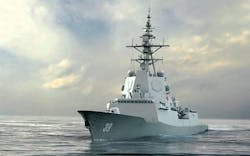Planned capabilities may give small surface warships the reach and punch of larger ships
THE MIL & AERO COMMENTARY, 12 Jan. 2016. Small surface warships like frigates and destroyers historically have been relegated to support roles as anti-aircraft and anti-submarine protection to larger ships like aircraft carriers and battleships.
Today that's no longer true. The U.S. Navy's Aegis-equipped Arleigh Burke-class destroyer, for example, is at the center of U.S. ballistic missile defense planning. With its ability to detect, track, and destroy short-to-immediate-range nuclear ballistic missiles in midcourse phase, the Burke-class destroyer is designed to play a central role in naval strategy, not just a supporting role.
Future technology advanced, however, aim to enable the small surface warship to play even more crucial roles in naval warfare, with anticipated new initiatives in place to provide small vessels with unmanned aircraft, sensors able to see through fog, rain, and snow, and high-resolution electro-optical sensors able to place a dome of long-range visibility and imaging over the entire ship.
Couple these projects with ongoing efforts to improve the sonar and anti-submarine warfare capability of small surface vessels and you have compact-yet-powerful weapons platforms able not only to escort the large capital ships, but also to operate independently over all the world's oceans and coastal waterways.
A pair of projects of the Office of Naval Research (ONR) in Arlington, Va., could play a key role in boosting the future capabilities of small surface warships.
Related: Navy looking for new sensor technologies to see through fog, haze, rain, and snow at sea
ONR last week issued requests for information to industry for potential projects aimed at improving the capabilities of shipboard electro-optical sensors and vastly enhance the surveillance and reconnaissance capabilities of surface ships.
The first initiative, called Imaging Through Obscurants, seeks to enable surface warship and submarine crews to capture images through difficult obscurants like fog, haze, rain, and snow.
This projects seeks nothing less than defeating one of the most severe weather challenges that has confronted mariners for thousands of years -- thick fog. Tiny droplets of moisture in fog scatter light and causes the familiar whiteout conditions that even today's most sophisticated electro-optical sensors cannot penetrate.
The ONR project seeks to sensor post processing that uses prior information about the scene, as well as overcoming limitations that scattering water-based aerosols impose on the signal-to-background ratio of infrared and visible-light sensors.
Related: Navy approaches industry for electro-optical dome of imaging over surface warships
The implications of a successful program could be tremendous. Imagine surface ships that could steam in formation at high speeds through even the thickest fog. This capability could enable ships to navigate safely and avoid collisions in congested harbors enshrouded in fog. The biggest benefit, however, would be enhance ability to detect and respond to enemy threats in the worst of weather conditions.
story continues below
Also last week ONR released a request for information for the Hemispherical Imaging for Situational Awareness project to create a dome of imaging capability around surface ships. This would enable ship crews to monitor the entire hemispherical dome (360 degrees azimuth by 90 degree vertical) for potential threats around surface vessels -- a job for which today's conventional imaging sensors are too inefficient.
The idea is to help ship crews maintain situational awareness in the open ocean, along coasts, and inside harbors to detect, locate, and track potential airborne and surface threats like missiles and fast attack boats -- with imaging technology that offers far higher resolution than radar.
Speaking of improved situational awareness, the U.S. Defense Advanced Research Projects Agency (DARPA) in Arlington, Va., is tapping Northrop Grumman Corp. to develop unmanned aerial vehicles (UAVs) able to operate from small surface warships, or perhaps even civil cargo vessels.
Related: Builders looking into submarine-hunting vessels quiet enough to sneak up on submarines
This initiative, part of the DARPA Tactically Exploited Reconnaissance Node (TERN) program, could enable small ships not designed to accommodate manned helicopters to reach out far beyond line of sight to look for threats, perform search and rescue, or other maritime tasks.
Now couple these situational awareness capabilities with separate projects to create the most quiet surface ships ever built. The United Kingdom Royal Navy is working on a new Global Combat Ship with advanced electric propulsion motors and drive systems with vibration-damping technology to enable the ship to hunt submarines more effectively without being detected.
We're talking about future small surface warships with over-the-horizon reach that can operate normally in fog and other bad weather, and that could be quiet enough to sneak up on enemy submarines. Surface warfare is getting set for a quantum leap in capability.


